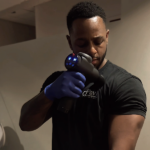Health trackers have fallen into widespread use across all sectors of society. From the individual who uses a wearable fitness tracker to help with their workout progress to the employer who wants to use wearables for a more health-conscious workplace, wearable technology has begun to pop up in many different niches.
Enhancing workplace well-being
Wearable trackers can monitor a range of different health factors. For example, consider those workers who have positions that require them to sit down for much of the day. Short breaks to stretch and move around can have significant health benefits for such individuals. Providing these workers with a fitness tracker and advice on regular stretching and movement could help them develop more healthy habits.
Another example might be workers who are required to undertake strenuous or dangerous work and whose safety might be compromised by fatigue. Wearable technology can detect whether or not the employee is taking sufficient rest breaks to avoid accidents or overwork.
Reducing the cost of sickness and healthcare
Healthier workers mean less money lost to sickness. Keeping workers in good health cuts down on the number of sick days they need to take and ensures that when staff are present, they are performing at their peak instead of struggling with illness.
Using wearable technology to support good health in the workplace can also reduce healthcare costs. When employers called upon to make fewer claims for health insurance, healthcare costs are reduced.
Benefits for employees’ families
When a working adult is coping with ill-health, it’s not only the individual who suffers. Families may find their income reduced and may be faced with stress and uncertainty. Conversely, when employees are fit and active, this has benefits for their families. Healthier habits acquired in the workplace will likely be transplanted to the rest of the household, resulting in healthier partners and children. This, in turn, could potentially reduce the cost of healthcare to the company as a whole.
Detection and prevention of chronic disease
Many chronic conditions can lurk undetected for many years before they reveal themselves. Early interventions can make treatment easier or even halt some diseases in their tracks. One example is diabetes. Millions of Americans are pre-diabetic without even realizing it. Prompt diagnosis and treatment, whether through medication or simple lifestyle interventions, can slow or even prevent the development of full diabetes in a majority of patients. The same may be true of many other conditions, particularly those affecting the heart and lungs.
A health tracker may be able to pick up on these issues early on, either by registering variations in vital signs that may hint at a problem in the future. Wearables may also help forestall these conditions by making both the wearer and the employer aware that the employee’s lifestyle is predisposing them to health issues.
Better morale
Being issued with, or even encouraged to use, a wearable health tracker is a symbol of an employer’s investment in each individual. If, for instance, an employer arranges for a bespoke health tracker app to be developed for their employees to use, this is a strong signal to workers that their well-being is valued. Knowing that their health is important enough to encourage can be a real morale boost in the workplace.
To be effective in improving workplace health, wearable technology should be chosen with care. Wearables can be made to be multi-functional, which is useful in the workplace. It might be advantageous if, say, an employee’s health tracker watch could also be used to undertake useful tasks such as issuing reminders about meetings or recording data such as catalog numbers. The best health wearable may be a dedicated fitness tracking device, or it may be something that performs other functions as well. In the interests of personal privacy, employers also need to be very conscious of the way that data collected by wearable devices is stored and used.
Tap for recommended posts on the tags you don’t follow





